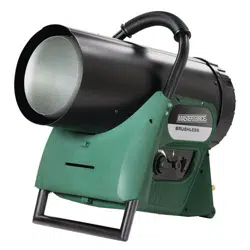Loading ...
Loading ...
Loading ...

Accidents are always tragic especially be-
cause so many of them could have been
prevented with little care and good judgment.
• Children should be supervised, when they
are in the area.
• Always maintain proper clearance from
combustible materials. Minimum clearance
from combustibles: Side - 24” (61 cm); Top
- 48” (121.9 cm); Front - 72” (183 cm). Floor
- combustible. Not for use on nished oors.
• Heater must be placed on a level and stable
surface.
• Never place anything including clothes
or other ammable items on the heater.
• The appliance area shall be kept clear and
free from combustible materials, gasoline
and other ammable vapor and liquids.
• Do not modify or operate a
heater which has been modied.
• Adequate clearance for accessibility
and for combustion & ventilation air
supply must be maintained at all
times when the heater is operating.
• Service and repair should be done by a
qualied service person. The heater should
be inspected before each use and at least
annually by a qualied person. More frequent
cleaning may be required as necessary.
Do not service while hot or operating.
• Never connect heater to an unregulated gas
supply.
• The heater is shipped from the factory for
LP(Propane) gas. This heater is for use with
propane gas only, do not convert heater to
any other gas. Installation must conform
to local codes or, in the absence of local
codes, with the standard for the Storage
and Handling of Liqueed Petroleum Gases
ANSI/NFPA 58 and the Natural Gas and
Propane Installation Code CSA B149.1
• The minimum and maximum inlet pressures
to the regulator from the gas tank are
25 psi minimum and bottle pressure,
respectively. Use only the regulator &
hose assembly provided with the heater.
Inspect the regulator/hose assembly
prior to each use of the heater. If there is
excessive abrasion or wear, or hose is cut,
replace with regulator/hose assembly listed
on the parts list prior to using this heater.
GENERAL SAFETY INSTRUCTION
IMPORTANT SAFETY INSTRUCTION
• Gas supply connections should be checked
using a 50/50 solution of liquid dish soap and
never use a ame to check for gas leaks.
• The electrical connection & grounding must
comply with National Electrical Code. ANSI/
NFPA 70 or in Canada CSA C22.1, Canadian
Electrical Code, Part 1. Use only a properly
grounded three (3) prong receptacle.
• Do not restrict inlet or outlet by any
means. The ow of combustion and
ventilation air is not to be obstructed.
• This heater should not be directed toward
any propane-gas container within 20 ft
(6M). The heater must be located at least
6 ft. (1.83 m) in the U.S.; or 10 ft. (3 m) in
Canada, from any propane gas container.
• The propane cylinder supply system
must be arranged to provide for vapor
withdrawal from the operating cylinder.
• This heater is not to be used with external
thermostats, timers or other devices that
control or alter electrical supply to the heater.
• For indoor use. Adequate ventilation shall
be provided in accordance with OSHA
29 CFR 1926.154, Safety Requirements
for Temporary and Portable Space
Heating Devices and Equipment ANSI
A10.10, ANSI 223.1 / NFPA 54, Liquied
Petroleum Gas Code, NFPA 58 or the
National Gas and Propane Installation
Code, CAN B149.1 as appropriate.
• The minimum clearances to combustible
materials: Side - 24” (61 cm); Top - 48”
(121.9 cm); Front - 72” (183 cm); Floor -
combustible, must be maintained at all times.
• The hose assembly should be visually
inspected prior to each use of the heater. If it
is evident that there is excessive abrasion or
wear, or the hose is cut, it must be replaced
prior to the heater being put into operation.
• The replacement hose assembly shall be
that specied by the manufacturer (Refer to
parts list).
• The heater shall be installed such that it
is not directly exposed to water spray, rain
and/or dripping water.
Below are some basic good practices, we
hope you will follow for safe use of your heater.
Page 5
Loading ...
Loading ...
Loading ...
